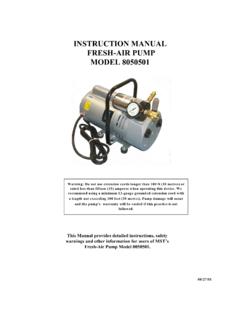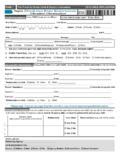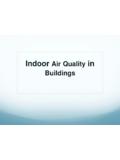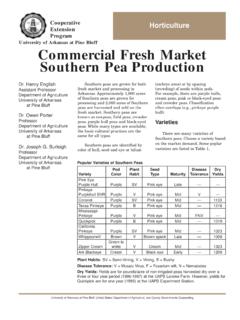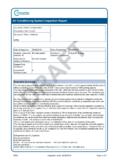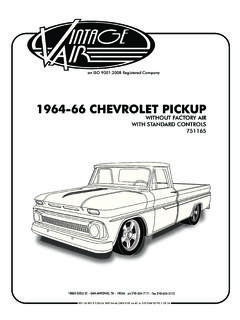Transcription of Textile Industry Hazards - O ECOTEXTILES ::: Indulgent yet ...
1 Textile Industry POSES ENVIRONMENTAL HAZARDSO ECOTEXTILES the producer of high quality, organic fabrics hopes to raise awarenessabout Textile choices and support environmentally preferable processes, practices,power sources and materials, from the start of the Textile s process to its arrival inhomes. O ECOTEXTILES aims to change the way fabrics are made, by proving that it'spossible to produce luxurious, sensuous fabrics in ways that are non-toxic, ethical Textile Industry has been condemned as being one of the world s worst offenders interms of pollution because it requires a great amount of two components: Chemicals: as many as 2,000 different chemicals are used in the Textile Industry ,from dyes to transfer agents.
2 And Water: a finite resource that is quickly becoming scarce, and is used at every stepof the process both to convey the chemicals used during that step and to washthem out before beginning the next step. The water becomes full of chemicaladditives and is then expelled as wastewater; which in turn pollutes theenvironment:o by the effluent s heat;o by its increased pH;o and because it s saturated with dyes, de-foamers, bleaches, detergents, opticalbrighteners, equalizers and many other chemicals used during the produced fabrics contain residuals of chemicals used during theirmanufacture chemicals that evaporate into the air we breathe or are absorbed throughour skin.
3 Some of the chemicals are carcinogenic or may cause harm to children evenbefore birth, while others may trigger allergic reactions in some people. According to aJune 5, 2005 article in Business Week, the population that is allergic to chemicals willgrow to 60 percent by the year ECOTEXTILES hopes to make environmentally appealing technologies appealing andavailable to the mainstream, and to be among the forefront of companies raisingpeoples consciousness about the far-reaching implications of their Textile choices. Assuch, O ECOTEXTILES ensures that its partners and products do not: support the sale and use of chemical pesticides and fertilizers to grow the fibers,which poison our soils and pollute groundwater; pollute wastewater; O ECOTEXTILES mills treat their wastewater so it doesn tdegrade our streams and waterways; contain harmful chemical residues that evaporate into the air or are absorbedinto skin; accumulate in landfills; O ECOTEXTILES fabrics biodegrade (given conditions thatallow it to proceed).
4 Come from producers who pay unfair wages or have poor working Usage:The Textile Industry is one of the most chemically intensive industries on earth, and theNo. 1 polluter of clean water (after agriculture). It takes about 500 gallons of water toproduce enough fabric to cover one sofa. Half a billion people already live in regionsprone to chronic drought, and by 2025, that number is likely to have increased five-fold,to between one-third and one-half of the entire world population. Global consumptionof fresh water is doubling every 20 ECOTEXTILES is thrilled to have a relationship with a mill based in southern Italy, whichuses no water for the weaving Pollution:Mills discharge millions of gallons of effluent each year, full of chemicals such asformaldehyde (HCHO), chlorine, heavy metals (such as lead and mercury) and others,which are significant causes of environmental degradation and human illnesses.
5 Themill effluent is also often of a high temperature and pH, both of which are of the mills O ECOTEXTILES uses have wastewater treatment in place. Every 25 metersof an O ECOTEXTILES sofa fabric prevents 2,300 liters of chemically infusedeffluent about the size of a California hot tub and containing from 1 to 10 kg of toxicchemicals from entering the environment. (Based on VPI study for Dept. ofEnvironmental Quality for the state of Virginia.)Fibers:O ECOTEXTILES emphasizes the use of the "bast" fibers such as hemp, linen, and abaca. A"bast" plant is one where the fiber that is spun into yarn comes from the stalk, and notthe flower of the plant.
6 Bugs don't munch on stalks, so the plants can be grown withoutpesticides. O ECOTEXTILES fibers include: Hemp and Flax (Linen) made from water-retted hemp, employing biologicalprocesses to extract the fiber from the stalk. The colors of the fibers vary,depending on the weather during cultivation and retting, yielding subtle, naturalvariations. Bamboo used by O ECOTEXTILES does not impact Panda habitats. Almost allbamboo fiber is made using the viscose process (non-viscose bamboo fiber is toocoarse for furnishings or apparel), which employs sulfuric acid (often improperlyhandled because the processes are so laborious and expensive).
7 O ECOTEXTILES isproud to produce bamboo viscose with minimal deleterious environmentaleffects. In its wastewater, sulfuric acid is sequestered completely and neutralizedusing ECOTEXTILES uses only fibers that have been grown without any toxic pesticides,herbicides, or chemical fertilizers. The company supports maintenance of healthy soils,which in turn helps minimize global is the second-most damaging agricultural crop in the world; 25 percent of allpesticides used globally are put on cotton crops. Most cotton is irrigated, and thecombination of chemical application (through pesticides and fertilizers) with irrigationis a direct conduit for toxic chemicals to circulate in groundwater worldwide.
8 AlthoughO ECOTEXTILES uses organic cotton, we try to de-emphasize its use because organic cottonis too thirsty a crop for most of the areas where it is grown. O ECOTEXTILES takes care toassure that the organic cotton we use comes from fields that enjoy natural rainfallsufficient to irrigate the crops. In this way, the desertification of vast areas of the globe -as in Kazakhstan and Uzbekistan around the Aral Sea - does not result inenvironmental :At O ECOTEXTILES mills, no polyvinyl alcohol (PVA) is used; the company requires itsmills to use potato starch or carboxymethylcellulose (CMC) which is cellulose dissolvedby an acid to become a liquid.
9 It is used in food and is chemically inert and non-toxic and is allowed under Global Organic Textile Standard :Chlorine bleach is known to be extremely toxic to the environment and to consumers,yet chlorine-based chemicals are still often used to bleach fabrics. In O ECOTEXTILES mills, the bleaching method must be oxygen-based (hydrogen peroxide) and thewastewater is treated. In one mill, ozone, a very new technology, is used for technology relies on cool water (rather than having to maintain the fabric in a hotwater bath for many hours) and the ozone breaks down into water and :Many Textile manufacturers use dyes that release aromatic amines ( , benzidine,toluidine).
10 Dyebath effluents may contain heavy metals, ammonia, alkalai salts, toxicsolids and large amounts of pigments - many of which are toxic. About 40 percent ofglobally used colorants contain organically bound chlorine, a known dyes are rarely low-impact, depending on the specific dye and mordant (the substance used to "fix" the color onto the fabric) such as chromium arevery toxic and high impact. The large quantities of natural dyestuffs required fordyeing, typically equal to or double that of the fiber s own weight, make natural dyesprepared from wild plants and lichens very high ECOTEXTILES uses low-impact reactive dyes in a closed-loop system.

